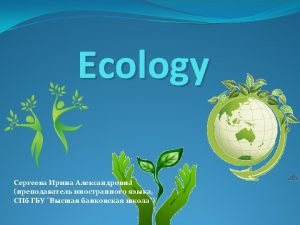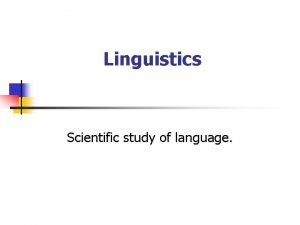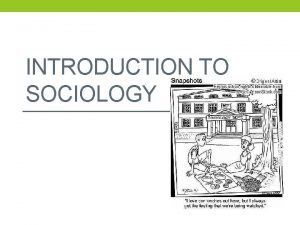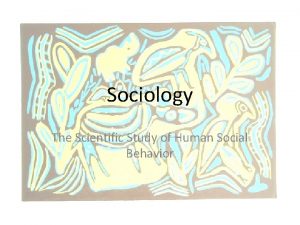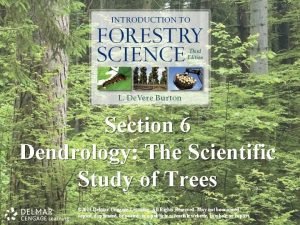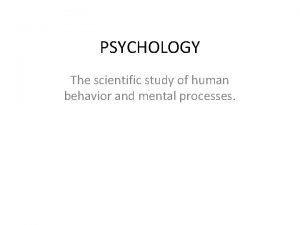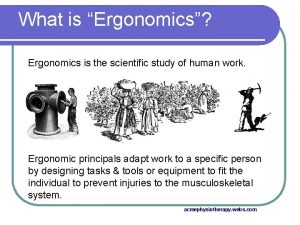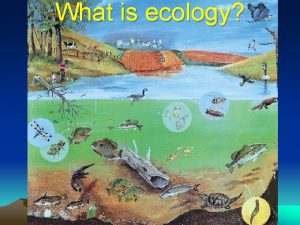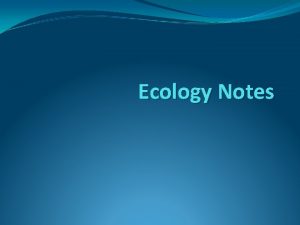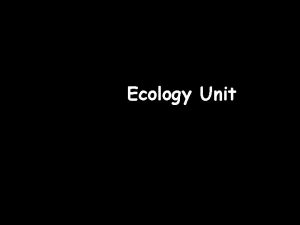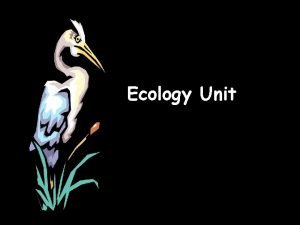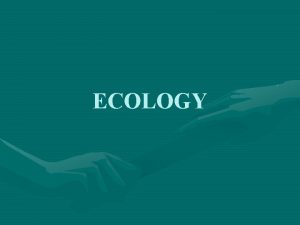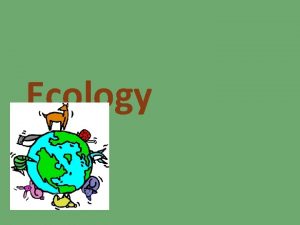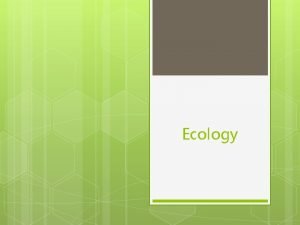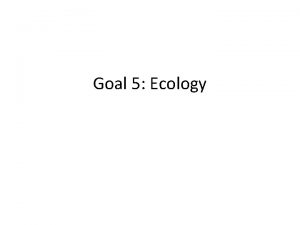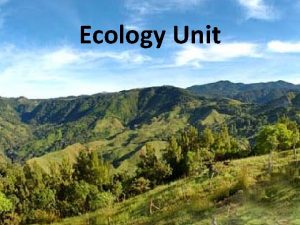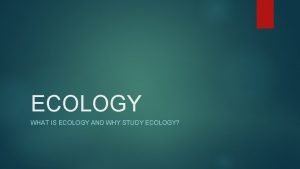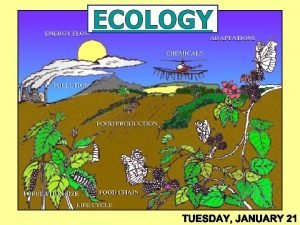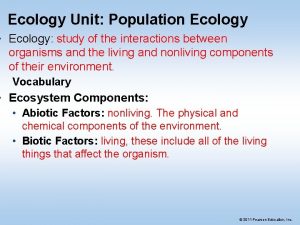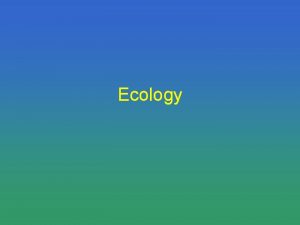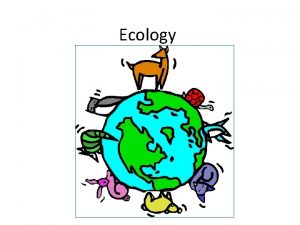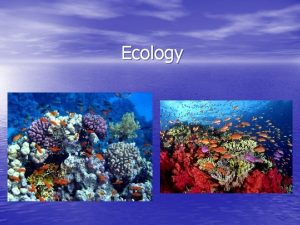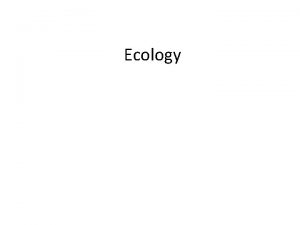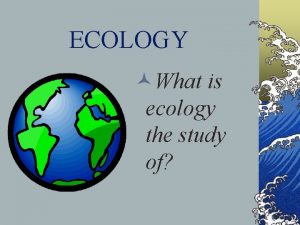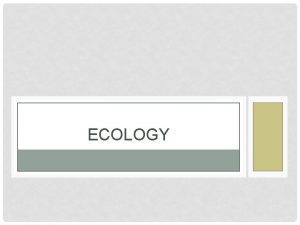What is Ecology Ecology is the scientific study































- Slides: 31

What is Ecology? • Ecology is the scientific study of the interactions of organisms and their environment. • All organisms live and interact in the biosphere. – The biosphere is the part of the Earth where life exists.

• To understand relationships between living things, ecologists must study events that occur withing a single individual as well as complex interactions in a range as large as the entire biosphere. – Ecologist study many levels of organization

Individual, Species, Population, Community, Ecosystem, Biome, Biosphere • Individual organism – Species: a group of similar organisms that mate and produce fertile offspring (babies can have babies). • Population: a group of individuals of the same species that live in the same area • Community: a collection of different populations that live together in an area


• Ecosystem: all of the organisms living in a specific place, together with their physical environment • Biome: a group of ecosystems with the same climate and similar dominant communities • Biosphere: the part of the planet (land, water and air) where all life exists

Temperate Deciduous Forest


Levels of Organization

Side Note: Ecological Succession - A process by which old growth climax communities are created overtime. Pioneer organisms

Energy Flows… • Energy flows through an ecosystem in one direction only. It flows from the sun (or chemical compound) to an autotroph and then to heterotrophs.

Energy Flow • Organisms must use energy from the environment for life processes (STERNGRR). – Living things get energy in different ways. • Sunlight is the main source of energy for life on Earth.

• Organisms that use the energy in sunlight or chemicals to make their own food are called producers. – Producers are also called autotrophs – Auto means self; -troph means feeding

Photosynthesis • Some autotrophs use sunlight to make food. This process is called photosynthesis. • Plants, algae, and some bacteria do this.

Chemosynthesis • Only some Bacteria Do This!!!!!! • Some types of organisms rely on the energy stored in chemical compounds

• Many organisms rely on other organisms for energy and food. They are called heterotrophs. – Hetero means different; -troph means feeding – Heterotrophs are also called consumers

Types of heterotrophs • Herbivores: such as cows, get energy by eating only plants. • Carnivores: such as snakes, get energy by eating only animals.

Types of heterotrophs • Omnivores: such as humans, get energy by eating both plants and animals.

Types of heterotrophs • Decomposers: such as fungi, break down organic matter.

Food Chain • A food chain shows how living things transfer energy by eating and being eaten. – For example a food chain might consist of: • Grass; a producer • Zebra; a herbivore • Lion; a carnivore

Food Web • A food web links together all of the food chains in a ecosystem.

Temperate Deciduous Forest Food Web

Trophic Levels • Each step in a food chain or food web is called a trophic Level – Remember trophic means feeding • Producers are at the first trophic level • Consumers make up higher trophic levels • EACH CONSUMER DEPENDS ON THE TROPHIC LEVEL BELOW IT FOR ENERGY

Trophic Levels

Ecological Pyramids • Ecological Pyramids are diagrams that show the relative amount of energy or matter at each trophic level. • The types of ecological pyramids are: – Energy Pyramids: Energy pyramids show much energy is available at each trophic level. – Biomass Pyramids: Biomass pyramids show the biomass (total amount of living tissue) at each trophic level. – Pyramid of numbers: Pyramid of numbers shows the relative number of individual organisms at each trophic level.

Energy Pyramid • Only about 10 percent of the energy available at one trophic level is passed on to organisms at the next trophic level. 100 kcal 1, 000 kcal 10, 000 kcal

Biomass Pyramid • Illustrates the amount of living tissue, at each trophic level. **Notice that each category is measured in kg/km 2 **

Pyramid of Numbers • Shows the relative number of individual organisms at each trophic level

What Shapes an Ecosystem? • Organisms in ecosystems are affected by both biotic and abiotic factors. – Biotic factors: are all of the living things with which organisms interact. – Abiotic factors: are non-living, physical things like temperature, soil and water.

Biotic and Abiotic Factors

Habitat • A habitat is the area where an organism lives. • A habitat has both biotic and abiotic factors.

Niche • A niche includes all of the abiotic and biotic things in an organism’s habitat and the way the organism uses those things.
 Information gathered during an experiment
Information gathered during an experiment How is a scientific law different from a scientific theory?
How is a scientific law different from a scientific theory? Biology ecology study guide answer key
Biology ecology study guide answer key Chapter 3, section 1: community ecology answer key
Chapter 3, section 1: community ecology answer key Ecology is the study that helps to preserve
Ecology is the study that helps to preserve The scientific study of language
The scientific study of language Social psychology is the scientific study of
Social psychology is the scientific study of Herbert spencer introduction
Herbert spencer introduction Scientific study of social behavior and human groups
Scientific study of social behavior and human groups The scientific study of trees
The scientific study of trees The scientific study of behavior and mental processes
The scientific study of behavior and mental processes Finished files are the result of years of scientific study
Finished files are the result of years of scientific study Ergonomics is the scientific study of
Ergonomics is the scientific study of Mendelian genetics vocab
Mendelian genetics vocab Hình ảnh bộ gõ cơ thể búng tay
Hình ảnh bộ gõ cơ thể búng tay Lp html
Lp html Bổ thể
Bổ thể Tỉ lệ cơ thể trẻ em
Tỉ lệ cơ thể trẻ em Chó sói
Chó sói Tư thế worm breton
Tư thế worm breton Chúa sống lại
Chúa sống lại Các môn thể thao bắt đầu bằng tiếng đua
Các môn thể thao bắt đầu bằng tiếng đua Thế nào là hệ số cao nhất
Thế nào là hệ số cao nhất Các châu lục và đại dương trên thế giới
Các châu lục và đại dương trên thế giới Cong thức tính động năng
Cong thức tính động năng Trời xanh đây là của chúng ta thể thơ
Trời xanh đây là của chúng ta thể thơ Mật thư tọa độ 5x5
Mật thư tọa độ 5x5 101012 bằng
101012 bằng Phản ứng thế ankan
Phản ứng thế ankan Các châu lục và đại dương trên thế giới
Các châu lục và đại dương trên thế giới Thể thơ truyền thống
Thể thơ truyền thống Quá trình desamine hóa có thể tạo ra
Quá trình desamine hóa có thể tạo ra




